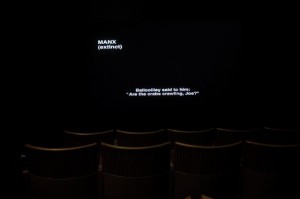PREVIOUSLY…
I got Long Covid, badly. Mostly hit me neurologically; Parkinsons’s and ME type symptoms.
Then my wife got anal cancer. She’s been in remission for 2 years now, thank fuck… and we’re rebuilding our lives from that, slowly.
Meanwhile, we watched, isolated and housebound, as pretty much everyone else in the world who wasn’t a crip just decided to say Fuck Masks. Genocide as convenience. While literal fascism roams the land.
As a result of this, my magic has become more… militant. I say no more.
Yeah, so not had many spoons, as they say.
But as the year is ending – and also my infrequent newsletter is having to shut down because Mailchimp are cunts – I’m making a resolution.
To write shit down. Keep broadcasting when I can. Here, mostly.
I’m on as many of the non-Twitters as are reasonable (I hate Instagram the most, Bluesky, fucking Facebook or dear Tumblr probably easiest for me to actually see it.) But if it’s longer than a not-tweet, I’ll say it here.
I maintain a list of other contact points here: https://linktr.ee/catvincent
Like John Wick, I’m thinking I’m back.
Because I am angry, scared and so very disappointed in my fellow humans for the most part and am disinclined to take any shit from them, ever again. And I will keep talking, keep writing, while I still can.
I have the hardware and nous to keep going if my neurology worsens.
I will therefore remain to remind you that this bitter old cunning-man, somehow about to turn 60 years old, is far from done.
After all these years of pain, fear, illness, rising literal fucking fascism and the worst of cyberpunk futures without hardly any of the good bits, I have come to a realisation. Well, a working model for me that fits the data.
This is Hell.
Once I realised and accepted that, the symbolism of that path kicked in hard.
It mostly stemmed from the continual use of it as a process and metaphor in Nick Harkaway’s Gnomon, which as I mention below has become to me what The Invisibles is for most chaotes – it combined so well with my stuff.
The process is called Catabasis. And you know how I love those cat puns.
At least while I walk through Hell (symbolically – only places I walk outdoors these days is to and fro doctors), life itself is not awful here. We’re both as well as possible considering, our son’s here for the holidays, I’m on a good drug regime for the symptoms.
And oh yeah I FUCKING KICKED FENTANYL.
Been on patches since the spine started some nine years ago – only thing that controlled the level 10 shooting arm pain – and was just left on them after the 2017 cyborg operation until my GP realised they could possibly be adding to my chronic fatigue and so we agreed to wean me off that shit.
I have to say my mood – which has ranged from black humour to black horror to black depression (to thankfully occasionally loving horniness with the missus which keeps us both stable, frankly) – immediately improved. But then again, they put me on that ol’fashioned morphine to wean me off the fentanyl and I also have weed so I am currently feeling pretty fucking good, to be honest. At least, the constant roar of pain is a murmur for now, so I can rub two brain cells together for once.
I had lost my optimism completely, in my catabasis. But now I remember the old battle-words…
We do not fight Nazis because we think we will win.
We fight them because they are fucking Nazis.
Solidarity with the fighters for freedom under fascism.
Yes, that includes Palestine, and oppressed Jews.
It especially includes trans, non-binary and queer people.
I think you may have gathered, crip people especially.
It includes any victim of those beliefs which Iain Banks condemned – any cause that makes children die.
Fuck them. The Useless Eaters will outlast your neglect and contempt out of pure fucking spite, one by one, until we go.
But that’s the thing about disabled people… life just keeps making more and more of us.
Anyway, on to more cheery stuff to see the new year out.
—
I read a lot of fiction. Because of my spinal injury, I have to read books solely as ebooks, on a tablet strapped above my head in bed, and that posture’s good for the cyborg spine bits so I read a couple of hours every night. Only fiction, or there’s a higher chance of bingeing-until-dawn/taking extensive notes like I’m on the fucking Rocinante on the float. (I stop on good cliffhanger chapters.)
Honestly, half of what I read this year was fairly generic genre material off Kindle Unlimited… but of the good stuff, I’d recommend…
A Half-Built Garden by Ruthanna Emrys – a very queer and trans friendly cozy post-apocalypse first contact story. Rich, deep, reads like silk. Just wonderful.
Conquest by Nina Allan – another banger by one of the most underrated women in Brit SF, this one a quietly told tale of a possible alien invasion only detected by a small group of late C20 conspiracy theorists (who, synchronistically enough, all seem to have lived in my various ends in Kent and South East London!).
The Exoskeleton Quartet by Shane Stadler – This is an extraordinary set of books exploring the human condition, always the core goal of SF, but it comes with a huge content warning because the first book is roughly 80% body horror about using a medically connected exoskeleton on condemned prisoners to automate causing severe agony in order to force out-of-body experiences… the detail on this is described very precisely. But if you can bear such, it goes to some amazing places, and a fuckload of Nazis die horribly.
I’m a big fan of Gareth Powell, but I hadn’t read his earlier work so his breakthrough Ack-Ack Macaque series was quite something. Crafty and vicious dissection of war, VR and politics through its titular Spitfire Ace and all-around bad-ass macaque.
Kirsty’s reading has tilted heavily towards queer romance as comfort food, and occasionally points me to some. I’m glad to see the biggest genre in the world open up and be accepted more these days, as there’s some excellent writing to be found.
My favourites were The Unholy Trifecta series by AJ Sherwood (mostly gay but occasionally bi pairings of assassins, mercs and thieves with both civilians and their mutual battlefield adoption of a young girl who’s at least as smart as they are) and Colleen Cowley’s Clandestine Magic trilogy, a retelling of the early days of American Women’s Suffrage but in a universe where magic
A. works and
B. supposedly only men have it… and the woman who discovers that B. is a lie.
Another discovery was the work of qntm, a male Brit writer who debuted in the SCP Foundation forums with his short pieces, later fixed up into the book There Is No Antimemetics Division. Intensely clever but always readable, he delves into the impact on our world of anti-memes; ideas that do not want to be remembered or passed on, and take active measures to ensure this. All 4 of his novels are wonderful and I’d say Ed is the easiest entry point.
I liked Grant Morrison’s debut novel Luda well enough right up until the ending. Which was meh.
This was the year I discovered a sadly deceased woman SF writer had penned one of the all-time great time travel series.
Kage Baker’s The Company runs to some 12 novels and 5 novellas, the last story published some 3 years after her death in 2009.
These are just so damn clever. A megacorp discovers 2 world-changing pieces of kit: time travel (with limits) and immortality (with limits). In order to mazimise the profit from these, they recruit kids at the point of their deaths throughout time and send them back (often further back than their birth time) as immortal cyborg operatives to basically steal historical artefacts… and what happens when several groups of them rebel.(That time-travel-for-profit trick also pops up in our beloved St. Mary’s Priory series by Jodi Taylor, which continues to delight and, as usual, had a novel and a Xmas novella this year.)
It smartly keeps the focus throughout the series on a handful of characters – one of whom, The Botanist Mendoza, becomes one of the all great heroines and so much more. A wonderful discovery, and a sad loss.
And, as I have every year since publication, I reread Gnomon by Nick Harkaway, which has become for me what The Invisibles was for practically every chaos magician in the Nineties, except not deliberately. (Although Nick is certainly smart enough to note that writing a book about alchemy and synchronicity is likely to be conducive to both.) I learn more about myself and my times on every read.
I also read his latest, Titanium Noir: much shorter and less obviously complex, it’s a lean noir tale of a world where the rich (known as Titans) are, due to a side-effect of the immortality drugs only they get, physically huge. Guts capitalism with a stiletto.
Lots of telly – I praise the saints that someone got to make Slow Horses properly and that it’s a hit – and the usual constant FPS as my wellness sim.
Finished first Starfield run after wife let me get new XBox as early 60th/Xmas present. It was pretty fun, but buggy as fuck. Like life really – ooh, deep!
I really enjoyed Dead Island 2: found the Londoner character Jacob convincing and it’s a joy to play, like a less finicky Dying Light 2 – and funnier.
And a special shoutout to my online tabletop RPG groups. They’re the majority of my social life and I am so damn grateful for them. Extra big love to Tom and Matt, our GM’s.
So, you know, it’s not like Hell is that bad for me… but that constant hint of sulphur in every news item or development in automated callousness in the service of the TESCREAL fuckwits pervades everything.
Fuck them all.
Happy New Year.
May it bring you at least what you need, and only what you can bear.







